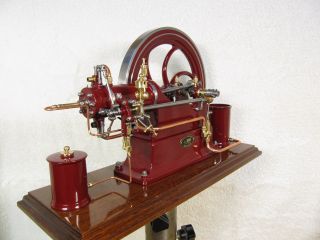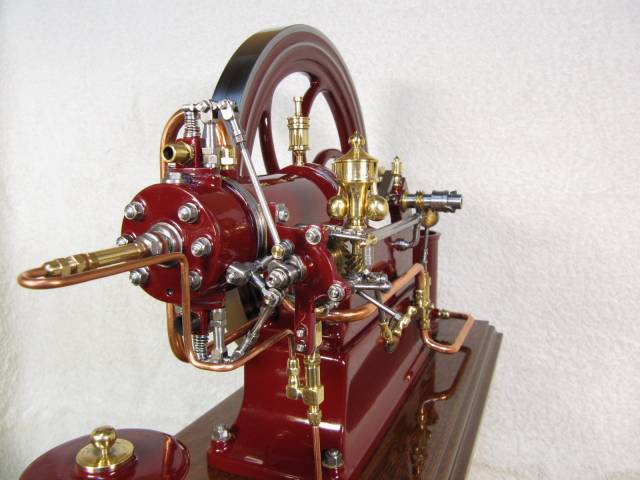




The picture show again yet from another angle, the cylinder-head.
A compression problem.
I had a minor problem at first with the engine, the compression was not good enough. I knew
by experience that a compression ignition engine must have 100 % compression, or it is very
difficult to start from cold, and will not run properly even when it is warm. The problem was
a leaky exhaust valve. I made a stronger valve-spring, witch solved the problem.
Talking about valves and valve-seats. I found that a small valve-seat face at about 0,30 mm.
together with a strong valve-spring with an opening load of about 280 gr., will keep the valve
from leaking, especially the exhaust valve witch is dealing with high temperature and sot.
Adjustable injection timing.
I made an arrangement for this engine too, to be able to adjust the injection timing when the
engine was running, A full adjust is about 8 degrees.


The pictures show in the middle, the fly-ball governor, and some handles. The
fly-ball governor speed brass handle pointing down, is to the right at the bottom
in the middle of the picture. To the left from this still at the bottom, is the adjustable injection timing brass handle still pointing down.
Above this the injection-pump steel handle, and above this the stop brass handle.
Engine specifications.
Engine build: 2013
.
Engine No.: 1-013
Bore-Stroke: 20-34 mm.
Compression ratio: 20-1 = 47 bar. = 148 kg. Load on 20 mm. Piston top.
Combustion pressure: 94 bar. = 295 kg. Load on 20 mm. Piston top.
Injection type: Direct injection into combustion-chamber in cylinder-head.
Injector type: 0,90 mm. Vibrating needle-valve, open against the combustion.
Fuel type: Kerosene mixed with 2 % mineral two-stroke engine oil.
Engine lubrication: Mineral engine oil with a grade of 15-40 to 20-50
Engine cooling system: Water cooled, using water-pump.

The pictures show the engine from two different angels.
Years ago I build some horizontal hot-bulb engines, I still had two unfinished left, so maybe one could be
converted to a diesel engine with some minor changes. I knew by experience that the compression ratio
should at least be 20--1, for an easy start and properly running, but the crankshaft made for the engine had
only a stroke of 30 mm., it was to little, the one used on my previous build diesel engines had 40--44 mm.
stroke. I had a spare crankshaft with 34 mm. stroke, so together with a cylinder head modification a
compression ratio of 20--1 could be achieved.
The engine viewed from the cylinder-head end, showing the intake - exhaust
valves and in the middle the injector. The fuel is injected directly into the
combustion camber, situated in the cylinder-head, between the valves.